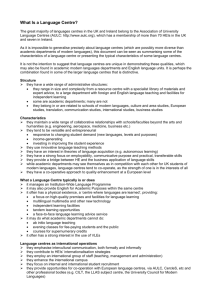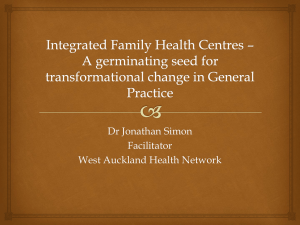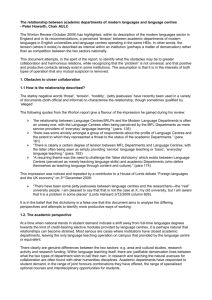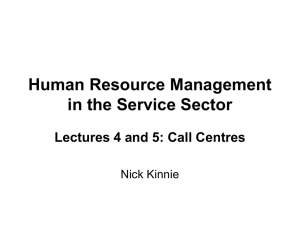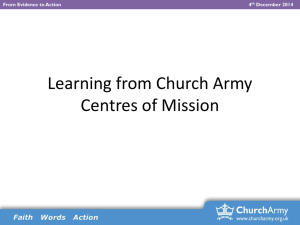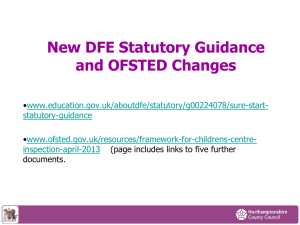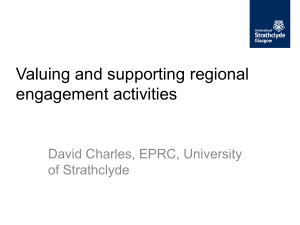New to Teaching - Association of University Language Centres
advertisement
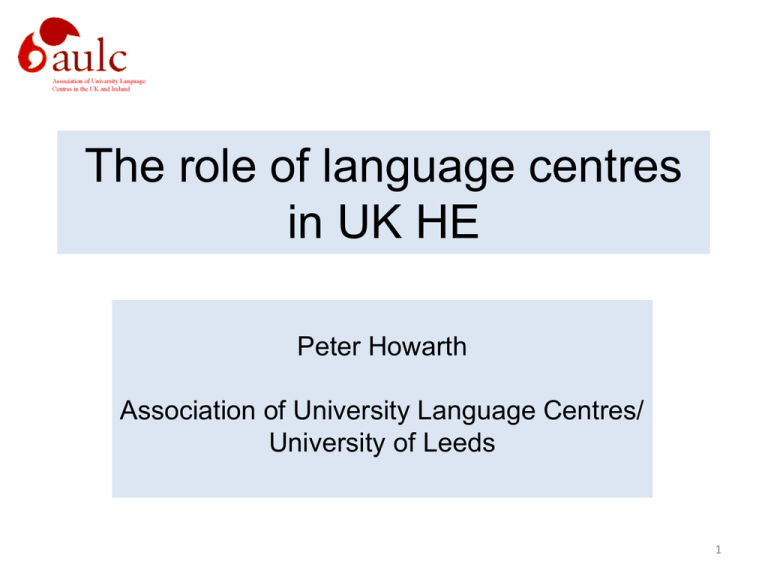
The role of language centres in UK HE Peter Howarth Association of University Language Centres/ University of Leeds 1 I will cover: • What is a language centre? • What does a language centre do? • The relationship between academic departments and language centres • Future trends? 2 What is a language centre? • Not all called ‘language centre’ • Diversity of structure – – – largest have integrated MFL, EAP and independent language study facilities (variety of media, technological infrastructure, open to all students and staff of the university): – e.g. the large London HEIs, the large civic HEIs: Manchester, Leeds, Southampton, Sussex, Oxford and Cambridge some only provide MFL teaching and learning resources. EAP provided by a separate unit: – e.g. Exeter, Warwick, Nottingham, Edinburgh some concentrate on providing independent learning resources • Fully integrated centres benefit from three-way collaboration • Where the EAP and MFL operations are separate, or have been separated, there may be an uneasy relationship or none (duplication of independent learning resources/language laboratories) 3 • Diversity of institutional location – Free-standing, central service, ‘Languages for All’ or IWLP – Within: • School of Modern Languages • Lifelong Learning • Communication studies • Business school • European Studies • Area Studies 4 AULC: Association of University Language Centres (UK and Ireland) • The great majority of language centres belong to AULC (http://www.aulc.org), which has 70+ members in the UK and 6 in Ireland (1 in West Indies). • Close relations with UCML, HEA and the LLAS subject centre. • Members do not see themselves as in competition with each other. • It provides professional support, shares information/advice among members, adverts for jobs and external examiners. • Institutional overlap with BALEAP. • Active member of CercleS (Confédération Européenne des Centres de Langues de l'Enseignement Supérieur) (http://www.cercles.org/) • half of members belong • in contact with 300 language centres in 26 countries via other national associations 5 What does a language centre do? • Core activity = some form of language teaching to students who • • are following non-language degree programmes in any faculty or are following language degree programmes (single or joint honours) and wish to study additional languages. • Although data are not easy to find (not included in HESA statistics), a figure of over 70,000 students and rising was quoted a few years ago, and we are currently conducting a new survey. • These sets of language courses may come under the title of InstitutionWide Language Programmes (IWLP), Languages for All, or seen as part of the university’s provision of elective modules. • Centres may provide courses: • • • • as elective modules for credit (over 1 or 2 semesters) as free courses for university students (centrally-funded) as fee-paying courses for students and members of the public In all cases, this provision may reflect a university’s belief that language skills are a good thing and that opportunities should be widely available. 6 • Wide range of languages offered on taught courses (typically 10-12 in Leeds; up to 18 in Manchester; more in London), from beginner to further advanced. • A key issue is building in progression through proficiency levels, over 1 or more years, while fitting in with the university’s model of academic levels and the student’s number of freely-available credits. • The range of languages may depend on local arrangements with academic departments, which may include joint posts: • for example, at Leeds the Department of Arabic and Middle Eastern Studies provides elective modules in Arabic, Turkish and Farsi, while the Language Centre has offered Punjabi and Urdu, amounting jointly to a good range of the languages of the region. • Language Centres focus a lot of effort and investment on learning technology and tend to be strong proponents of digital multimedia (e.g. satellite TV and language laboratories) and new technology. • Technology is language-neutral and the staff skills required are the same whatever the foreign language being taught- including EAP. 7 The relationship between academic departments and language centres • • • • • • This was highlighted by the Worton Report (Review of Modern Foreign Languages provision in higher education in England), published in October 2009 (http://www.hefce.ac.uk/pubs/year/2009/200941/). His investigation was an excellent opportunity for AULC to explain and promote what language centres do and what is distinctive about their activities. However, some sections of his report painted a rather negative picture: “the relationship between Language Centres/IWLPs and the Modern Language Departments is often an uneasy one, with the Language Centres often being perceived by the MFL Departments as mere service providers of ‘everyday’ language learning.” (para. 135) “there was some anxiety amongst a group of respondents about the profile of Language Centres and the extent to which they represented a threat to the status of the academic Departments.” (para. 161) “A recurring theme was the need to challenge the ‘false dichotomy’ which exists between Language Centres (perceived as merely teaching language skills) and academic Departments (who define themselves as teaching language through content and culture).” (para 174) 8 • Perceived 2nd-class status of those working in language centres. • Not necessarily a difference in financial insecurity. – MFL departments generally collaborate with other humanities departments (in joint honours teaching or in research), – language centres often work with STEMM and other disciplines in providing tailormade, professionally-oriented language training for business, medicine, engineering etc. This is perhaps a strategically beneficial direction to follow. • Avoid distinguishing between ‘specialists’ and ‘non-specialists’ • Following the report there was considerable activity, meetings with ministers and the setting up or strengthening of lobbying groups, in which AULC has had a role. The very strong message from government and HEFCE was to insist on collaboration. • Two projects in particular have focussed on joint efforts to revive, rescue or defend modern languages in HE (UCML, LLAS, AULC, HEFCE, HEA). 9 Projects 1. Shaping the Future (http://www.ucml.ac.uk/shapingthefuture), a website with case studies and other resources, available for language professionals to use to explain to their senior managements the essential significance of language learning in HE. The resources are categorized under three headings: ‘Identity’, ‘Internationalisation’ and ‘Employability’. 2. Speak to the Future (http://www.speaktothefuture.org/), a 5-year campaign with clearly-stated objectives relating to 5 levels of language use from primary school to graduate employment. The level of most relevance to us is: “Every graduate qualified in a second language”. Many language Centres organise Language Festivals on Mardi Gras. In Leeds this has encouraged collaboration between us and LeedsMet. 10 Trends Responding to demand- what will that be? • There may be greater opportunities for collaboration between LCs and non-humanities faculties (medicine, business, engineering); more vocationally-oriented learning; growth in some languages/levels and decline in others More or less fee-paying- what will be the effect of higher student fees? • Some universities may try to attract students with the offer of ‘free’ language courses for all. International students- will their numbers on elective modules continue to increase? • This is a significant aspect of internationalisation (students acquiring a 3rd, 4th etc. language while in the UK). 11 Many universities are engaged in curriculum review (e.g. ‘broadening strands’ in Leeds)- will this be an opportunity to improve the visibility of language skills? • Broadening the curriculum and re-defining ‘graduateness’ in relation to employability ought to result in languages being given more serious management support. Language policy- much talked about in some European countries and developed in a few UK HEIs. Will they catch on? • A UK version of a language policy tries to ensure that all undergraduates enter a university with a good GCSE in a foreign language and require those who don’t to follow a language course. • LETPP (Languages in Europe, Theory, Policy, Practice) (http://www.letpp.eu/) 12 Thank you Questions? 13
